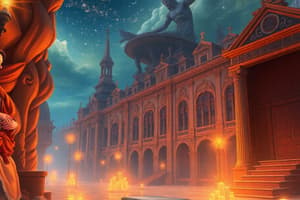Podcast
Questions and Answers
The term ______________________ music is used in a colloquial sense as a synonym for Western art music.
The term ______________________ music is used in a colloquial sense as a synonym for Western art music.
classical
___________________ sought to emulate the ideals of classical antiquity, especially those of classical Greece.
___________________ sought to emulate the ideals of classical antiquity, especially those of classical Greece.
Classicism
This taste for structural clarity began to affect music, which moved away from the layered _____________ of the baroque period toward a style known as ____________.
This taste for structural clarity began to affect music, which moved away from the layered _____________ of the baroque period toward a style known as ____________.
polyphony, homophony
Which of the following is not a Classical Period instrument?
Which of the following is not a Classical Period instrument?
At first the new style took over baroque forms—the ternary da capo ______________ and the ______________ and ______________.
At first the new style took over baroque forms—the ternary da capo ______________ and the ______________ and ______________.
The Italian composer Domenico ______________ was an important figure in the transition from baroque to classical.
The Italian composer Domenico ______________ was an important figure in the transition from baroque to classical.
The Sturm und Drang phase in the arts refers to ______________ and ______________.
The Sturm und Drang phase in the arts refers to ______________ and ______________.
The name Eroica means ______________, given by Beethoven for his 3rd Symphony.
The name Eroica means ______________, given by Beethoven for his 3rd Symphony.
Mozart rapidly came to the attention of Haydn, who considered the younger man his only true peer in music.
Mozart rapidly came to the attention of Haydn, who considered the younger man his only true peer in music.
What is the term that covers many pieces from the baroque and mid-eighteenth century that are not 'in sonata form'?
What is the term that covers many pieces from the baroque and mid-eighteenth century that are not 'in sonata form'?
The title for a single-movement piece of instrumental music is 'sonata.'
The title for a single-movement piece of instrumental music is 'sonata.'
Sonata form can be distinguished by all of the following except...
Sonata form can be distinguished by all of the following except...
There are variations of sonatas that include all of the following except...
There are variations of sonatas that include all of the following except...
Of the Eighth Symphony (1822), Schubert completed only the first two movements; this highly romantic work is usually called by its nickname 'The __________.'
Of the Eighth Symphony (1822), Schubert completed only the first two movements; this highly romantic work is usually called by its nickname 'The __________.'
The combination of bass drum, triangle, and cymbals, which eighteenth-century composers employed as a coloristic effect in so-called '_____________ music,' came to be increasingly used during the second half of the nineteenth century without connotations of genre.
The combination of bass drum, triangle, and cymbals, which eighteenth-century composers employed as a coloristic effect in so-called '_____________ music,' came to be increasingly used during the second half of the nineteenth century without connotations of genre.
Over the course of the nineteenth century, composers continued to subtract from the size of the symphonic orchestra.
Over the course of the nineteenth century, composers continued to subtract from the size of the symphonic orchestra.
At the beginning of the nineteenth century, Beethoven elevated the symphony to the highest potential of music.
At the beginning of the nineteenth century, Beethoven elevated the symphony to the highest potential of music.
Flashcards are hidden until you start studying
Study Notes
Classical Music Overview
- "Classical music" colloquially refers to Western art music spanning from the ninth century to the present, notably from the sixteenth to the nineteenth centuries.
Classicism and Its Ideals
- Classicism aims to emulate the ideals of ancient Greece, maintaining links to court culture and absolutism, marked by formality and order, yet characterized by a "cleaner" aesthetic.
Shift in Musical Style
- A transition from baroque's polyphony to homophony occurs, emphasizing melody over harmonic support, reflecting a desire for structural clarity.
Classical Period Instruments
- Guitar is not a Classical Period instrument, distinguishing it from clavichord, violin, and oboe.
Evolution of Musical Forms
- Early classical music adapted baroque forms like the da capo aria, sinfonia, and concerto, but with simpler composition, clearer ornamentation, and sectional divisions.
Domenico Scarlatti's Contribution
- Domenico Scarlatti is significant for transitioning from baroque to classical music, renowned for over 500 one-movement keyboard sonatas.
Influence of Romanticism
- The Sturm und Drang ("storm and stress") movement reflects early Romanticism's emotionalism, influencing composers like Haydn.
Beethoven's Eroica Symphony
- Beethoven's 3rd Symphony, Eroica, symbolizes the shift towards a heroic expression in music.
Mozart and Haydn's Relationship
- Haydn recognized Mozart's talents, viewing him as a true peer in the musical realm.
Sonata Form Basics
- Sonata form, widely used since the mid-eighteenth century, is a prominent large-scale structure in music theory, founded on its durability and diverse applications.
Single-Movement Pieces
- The term "sonata" encompasses many single-movement pieces from the baroque and mid-eighteenth century, not exclusively those in sonata form.
Characteristics of Sonata Form
- Sonata form is defined by key components, rejecting an incomplete exposition, featuring a separate development section, and typically showcases a full recapitulation.
Variations in Sonata Structures
- Various sonata structures may include a 'third subject group,' unique keys, or a first subject in a 'wrong' key, while excluding a polythematic exposition with material in the same keys.
Schubert's Unfinished Symphony
- Schubert's Eighth Symphony, known as "The Unfinished," includes only the first two movements, showcasing romantic elements.
Coloristic Effects in Music
- The combination of bass drum, triangle, and cymbals, termed "Turkish music," was used for coloristic effects, which became more common in the late nineteenth century without specific genre connotations.
Orchestra Size Trends
- Contrary to trends of subtraction, orchestras grew in size during the nineteenth century as composers expanded their musical expressions.
Beethoven's Symphony Evolution
- Beethoven transformed the symphony genre, elevating it from commonplace production to a supreme form for artistic expression, pushing the boundaries in fewer works.
Studying That Suits You
Use AI to generate personalized quizzes and flashcards to suit your learning preferences.



